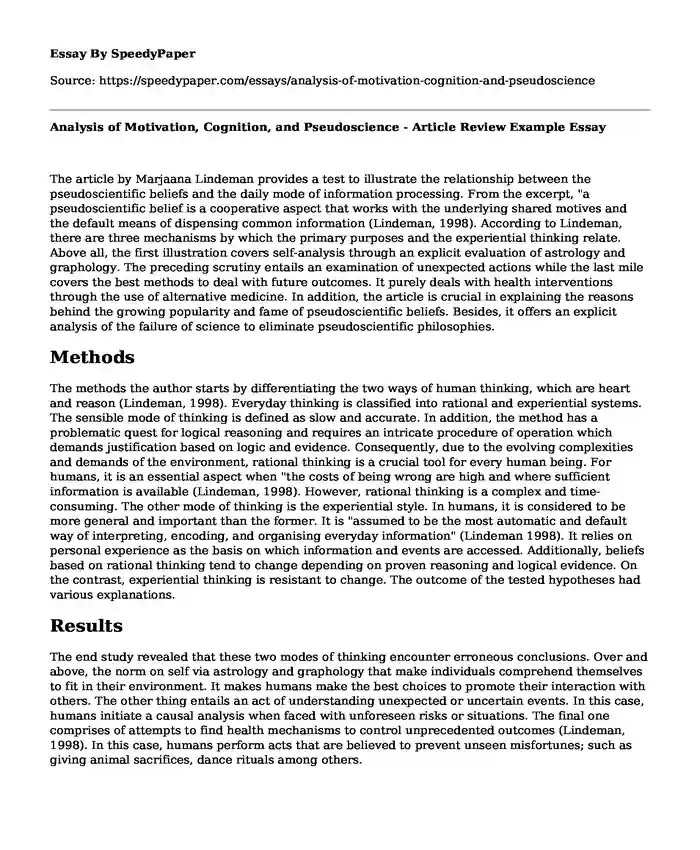
| Type of paper: | Article review |
| Categories: | Psychology Motivation |
| Pages: | 3 |
| Wordcount: | 612 words |
The article by Marjaana Lindeman provides a test to illustrate the relationship between the pseudoscientific beliefs and the daily mode of information processing. From the excerpt, "a pseudoscientific belief is a cooperative aspect that works with the underlying shared motives and the default means of dispensing common information (Lindeman, 1998). According to Lindeman, there are three mechanisms by which the primary purposes and the experiential thinking relate. Above all, the first illustration covers self-analysis through an explicit evaluation of astrology and graphology. The preceding scrutiny entails an examination of unexpected actions while the last mile covers the best methods to deal with future outcomes. It purely deals with health interventions through the use of alternative medicine. In addition, the article is crucial in explaining the reasons behind the growing popularity and fame of pseudoscientific beliefs. Besides, it offers an explicit analysis of the failure of science to eliminate pseudoscientific philosophies.
Methods
The methods the author starts by differentiating the two ways of human thinking, which are heart and reason (Lindeman, 1998). Everyday thinking is classified into rational and experiential systems. The sensible mode of thinking is defined as slow and accurate. In addition, the method has a problematic quest for logical reasoning and requires an intricate procedure of operation which demands justification based on logic and evidence. Consequently, due to the evolving complexities and demands of the environment, rational thinking is a crucial tool for every human being. For humans, it is an essential aspect when "the costs of being wrong are high and where sufficient information is available (Lindeman, 1998). However, rational thinking is a complex and time-consuming. The other mode of thinking is the experiential style. In humans, it is considered to be more general and important than the former. It is "assumed to be the most automatic and default way of interpreting, encoding, and organising everyday information" (Lindeman 1998). It relies on personal experience as the basis on which information and events are accessed. Additionally, beliefs based on rational thinking tend to change depending on proven reasoning and logical evidence. On the contrast, experiential thinking is resistant to change. The outcome of the tested hypotheses had various explanations.
Results
The end study revealed that these two modes of thinking encounter erroneous conclusions. Over and above, the norm on self via astrology and graphology that make individuals comprehend themselves to fit in their environment. It makes humans make the best choices to promote their interaction with others. The other thing entails an act of understanding unexpected or uncertain events. In this case, humans initiate a causal analysis when faced with unforeseen risks or situations. The final one comprises of attempts to find health mechanisms to control unprecedented outcomes (Lindeman, 1998). In this case, humans perform acts that are believed to prevent unseen misfortunes; such as giving animal sacrifices, dance rituals among others.
Criticisms
The study was accurate in identifying some of the errors experienced in understanding pseudoscientific beliefs. To have a better understanding of the notion, a real test from a sample of a population would give a better insight of the study. Population sampling from different regions preceded by the study would ultimately provide a stronger explanation. To get a precise analysis of this, population size, ages, and patterns are vital considerations for accurate results.
Conclusion
From the article, it is evident that people's beliefs on pseudoscientific beliefs are dependent on their ability to meet their primary motives. In addition, I understand that experiential thinking is what determines the extent to which humans should partake such values. I believe that positive beliefs about oneself are vital in enhancing mental health.
References
Lindeman, M. (1998). Motivation, Cognition and Pseudoscience. Scandinavian Journal of Psychology. Blackwell Publishers.
Cite this page
Analysis of Motivation, Cognition, and Pseudoscience - Article Review Example. (2022, May 05). Retrieved from https://speedypaper.net/essays/analysis-of-motivation-cognition-and-pseudoscience
Request Removal
If you are the original author of this essay and no longer wish to have it published on the SpeedyPaper website, please click below to request its removal:
- Skinner vs Rogers - Free Essay on Humanism and Behaviorism
- Marketing Essay Example: Differentiation Strategy in Competitive Advantage
- Free Essay on Health Issues Among Critical Care Nurses
- Essay Sample on the Olympic Games: Environment, Energy and Transportation Technology
- Essay Sample Exploring Theories of Criminal Behavior
- Essay Sample about Theatre Personnel: Production Manager
- Inflation, Unemployment, and the Fed - Economics Essay Example
Popular categories




